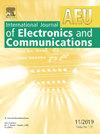具有低噪声和自动增益控制放大器的闭环神经记录模拟前端
IF 3.2
3区 计算机科学
Q2 ENGINEERING, ELECTRICAL & ELECTRONIC
Aeu-International Journal of Electronics and Communications
Pub Date : 2025-08-07
DOI:10.1016/j.aeue.2025.155976
引用次数: 0
摘要
本文提出了一种新型的模拟前端,包括模拟电路和模数转换器(ADC),用于闭环神经记录。模拟部分包括一个低噪声放大器(LNA)、一个自动增益控制放大器(AGCA)和一个电压缓冲器。为了优化噪声和功率性能,引入了一种新颖的LNA结构。所提出的LNA采用两个电流镜像放大器,都包含ab类输出级。此外,第一级利用源简并电流镜。使用AGCA可以在没有伪影的情况下动态调整电压增益,从而降低了对ADC的精度要求。这通过优化信号放大,同时最大限度地减少ADC的工作负载,提高了整体系统效率。采用10位逐次逼近寄存器(SAR) ADC对放大后的信号进行数字化处理。为了判断所建议的电路的运行,在Cadence环境下使用TSMC 180 nm CMOS技术进行了广泛的电路级模拟。该电路工作在1.8 V电源和37℃下,功耗为9 μW,处理带宽为10 kHz的信号。它的动态范围为81.83 dB,最大信噪比和失真比(SNDR)为58.40 dB,与该领域现有解决方案相比,具有竞争力。本文章由计算机程序翻译,如有差异,请以英文原文为准。
A closed-loop neural recording analog front-end with low noise and automatic gain control amplifiers
This paper presents a novel analog front-end including both an analog circuit and an analog-to-digital converter (ADC) for closed-loop neural recording. The analog part contains a low-noise amplifier (LNA), an automatic gain control amplifier (AGCA), and a voltage buffer. For noise and power performance optimization, a novel LNA structure is introduced. The proposed LNA employs two current mirror amplifiers, both incorporating class-AB output stages. Additionally, the first stage utilizes source-degenerated current mirrors. Using the AGCA allows for dynamic adjustment of the voltage gain during periods without artifacts, which reduces the precision requirements of the ADC. This improves overall system efficiency by optimizing signal amplification while minimizing the ADC’s workload. A 10-bit successive approximation register (SAR) ADC is incorporated to digitize the amplified signals. To judge the operation of the suggested circuit, extensive circuit level simulations were conducted using 180 nm TSMC CMOS technology within the Cadence environment. The circuit operates from a 1.8 V power supply and at 37 °C, consuming 9 μW of power while processing signals with a 10 kHz bandwidth. It reaches a dynamic range of 81.83 dB and a maximum signal-to-noise and distortion ratio (SNDR) of 58.40 dB, demonstrating competitive performance when compared to existing solutions in the field.
求助全文
通过发布文献求助,成功后即可免费获取论文全文。
去求助
来源期刊
CiteScore
6.90
自引率
18.80%
发文量
292
审稿时长
4.9 months
期刊介绍:
AEÜ is an international scientific journal which publishes both original works and invited tutorials. The journal''s scope covers all aspects of theory and design of circuits, systems and devices for electronics, signal processing, and communication, including:
signal and system theory, digital signal processing
network theory and circuit design
information theory, communication theory and techniques, modulation, source and channel coding
switching theory and techniques, communication protocols
optical communications
microwave theory and techniques, radar, sonar
antennas, wave propagation
AEÜ publishes full papers and letters with very short turn around time but a high standard review process. Review cycles are typically finished within twelve weeks by application of modern electronic communication facilities.

 求助内容:
求助内容: 应助结果提醒方式:
应助结果提醒方式:


